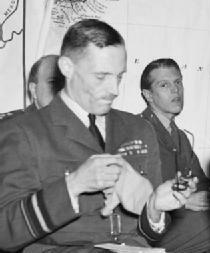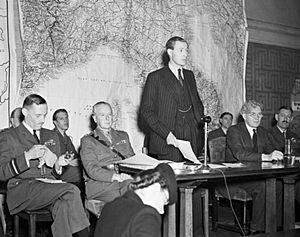William Gell (RAF officer) facts for kids
Quick facts for kids
William Gell
|
|
|---|---|

Air Vice-Marshal Gell in 1944
|
|
| Born | 10 July 1888 Birmingham, England |
| Died | 16 May 1969 (aged 80) Knowle, England |
| Allegiance | United Kingdom |
| Service/ |
British Army (1911–39) Royal Air Force (1939–45) |
| Years of service | 1911–45 |
| Rank | Air Vice-Marshal |
| Commands held | Balloon Command (1944–45) No. 30 (Balloon) Group (1941–44) No. 6 Balloon Centre (1939–41) 5th/6th Battalion Royal Warwickshire Regiment (1917–19) |
| Battles/wars | First World War Second World War |
| Awards | Companion of the Order of the Bath Distinguished Service Order & Bar Military Cross Territorial Decoration Silver Medal of Military Valor (Italy) |
William Charles Coleman Gell (born July 10, 1888 – died May 16, 1969) was an important officer. He served in both the British Army and the Royal Air Force. He became an Air Vice-Marshal, a very high rank in the Air Force. From 1944 to 1945, he led the RAF Balloon Command. This command was in charge of using large balloons to protect cities during wartime.
Contents
Early Life and Education
William Gell was born in Birmingham, England. His father managed an umbrella factory. William grew up in Edgbaston, a part of Birmingham.
He went to Malvern College for school. Then he studied law at Caius College, Cambridge University. After finishing university, he became a solicitor in Birmingham. A solicitor is a type of lawyer who advises people on legal matters.
Joining the Military
William Gell started his military journey in the Officers Training Corps. This was a common way for people to become officers without making it their full-time career. In 1911, he officially joined the Territorial Force. This was a part-time army for volunteers.
He joined a local regiment called the Royal Warwickshire Regiment. He first served in the 7th Battalion. Soon after, he moved to the 5th and 6th Battalions, also known as the Birmingham Rifles.
Service in World War I
William Gell fought in the First World War. He led the 5th/6th Battalion in France. He was very brave and earned the Military Cross award. He landed in France in March 1915.
In 1916, he was wounded during the Battle of the Somme. He continued to show great leadership. In 1917, he received the Distinguished Service Order (DSO). This was a special award for officers who showed bravery in battle. He later received a Bar to his DSO in 1919. This meant he had earned the award a second time. The Italian government also honored him with the Silver Medal of Military Valor.
Between the World Wars
After the First World War, Gell went back to his job as a solicitor in Birmingham. He also continued to serve in the Territorial Army.
In 1923, he married Edith Maud Gosling. They lived in Solihull, near Birmingham. In 1931, he was appointed a Deputy Lieutenant for the County of Warwick. This is a special role that helps the Lord-Lieutenant, who represents the King or Queen in a county.
Gell received the Territorial Decoration (TD) for his many years of service in the Territorial Army. In 1935, he joined the Anti-Aircraft branch. This part of the army was responsible for defending against enemy planes. In 1937, he became an Honorary Colonel of the 5th Battalion, Royal Warwickshire Regiment.
In 1939, he joined the Auxiliary Air Force as a Wing Commander. He was put in charge of No. 6 Balloon Centre. This was when the job of operating barrage balloons moved from the Army to the Royal Air Force.
Service in World War II

During the Second World War, William Gell played a key role. He commanded No. 5 and then No. 6 Balloon Centre. These centers used large balloons to protect British cities and military bases from German air attacks.
In 1940, he was promoted to group captain. In 1941, he became the Air Officer Commanding No. 30 Balloon Group. He continued to rise through the ranks. In 1943, he became an air commodore.
In 1944, he was appointed Air Officer Commanding-in-Chief at RAF Balloon Command. This meant he was in charge of all the balloon defenses. His successful leadership in protecting British cities was recognized. He was made a Companion of the Order of the Bath in June 1944. He retired from service in 1945.
Edith Gell's War Service
William Gell's wife, Edith Maud Gell, also served during the war. She joined the Auxiliary Territorial Service (ATS) in 1938. This was a women's branch of the British Army. She was one of the very first people to join the service.
By 1940, Edith Gell was a senior commandant. This was a high-ranking officer position. In 1941, the ATS became a formal part of the Army. Women officers were given military ranks. Edith Gell continued to serve and was recognized for her dedication. By 1944, she was a chief commander and received the OBE award for her six years of service.
Later Years
After the war, William Gell returned to his legal work. He continued to be involved with his law firm, Johnson and Co., in Birmingham for many years.

